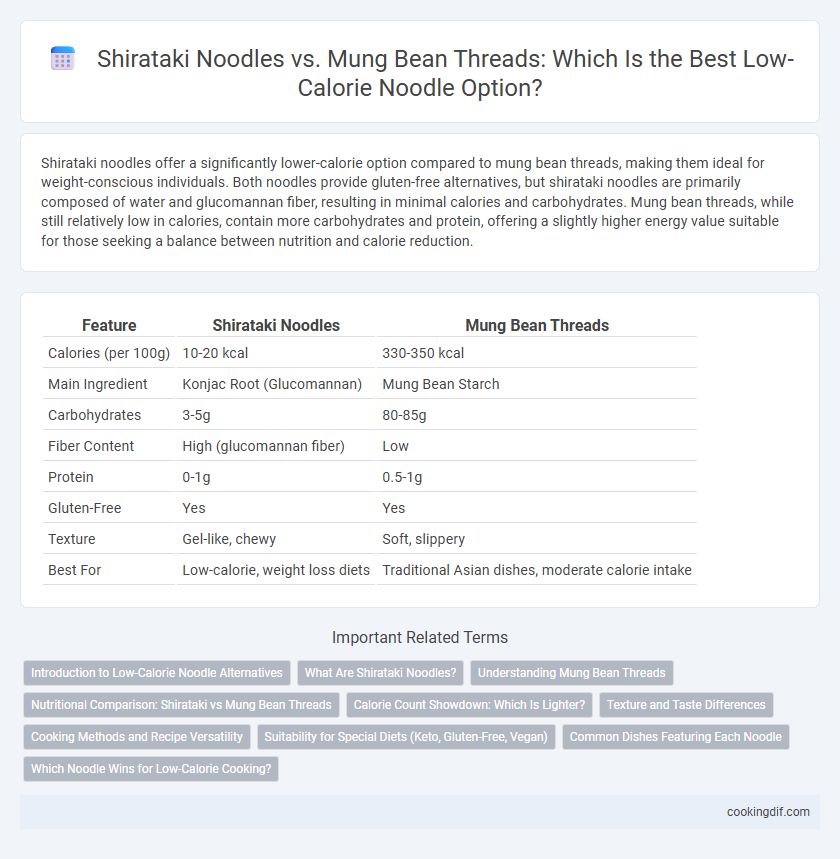Shirataki noodles offer a significantly lower-calorie option compared to mung bean threads, making them ideal for weight-conscious individuals. Both noodles provide gluten-free alternatives, but shirataki noodles are primarily composed of water and glucomannan fiber, resulting in minimal calories and carbohydrates. Mung bean threads, while still relatively low in calories, contain more carbohydrates and protein, offering a slightly higher energy value suitable for those seeking a balance between nutrition and calorie reduction.
Table of Comparison
| Feature | Shirataki Noodles | Mung Bean Threads |
|---|---|---|
| Calories (per 100g) | 10-20 kcal | 330-350 kcal |
| Main Ingredient | Konjac Root (Glucomannan) | Mung Bean Starch |
| Carbohydrates | 3-5g | 80-85g |
| Fiber Content | High (glucomannan fiber) | Low |
| Protein | 0-1g | 0.5-1g |
| Gluten-Free | Yes | Yes |
| Texture | Gel-like, chewy | Soft, slippery |
| Best For | Low-calorie, weight loss diets | Traditional Asian dishes, moderate calorie intake |
Introduction to Low-Calorie Noodle Alternatives
Shirataki noodles, made from the konjac yam, contain almost zero calories and are rich in glucomannan fiber, which aids in satiety and digestion. Mung bean threads, derived from mung bean starch, offer a low-calorie option with slightly higher carbohydrates and protein content compared to shirataki. Both noodles serve as excellent alternatives for calorie-conscious diets, with shirataki noodles being preferable for ultra-low-calorie intake and mung bean threads providing a more balanced nutrient profile.
What Are Shirataki Noodles?
Shirataki noodles, derived from the konjac yam, are a nearly calorie-free noodle option packed with glucomannan fiber, promoting a feeling of fullness and aiding in weight management. These translucent, gelatinous noodles contain minimal digestible carbohydrates, making them ideal for low-calorie and low-carb diets compared to mung bean threads, which contain higher calories and carbohydrates. Their unique texture and health benefits have positioned Shirataki noodles as a popular choice for those seeking gluten-free, low-calorie noodle alternatives.
Understanding Mung Bean Threads
Mung bean threads, also known as cellophane noodles, are a popular low-calorie alternative to traditional pasta due to their nearly negligible fat content and high water-solubility. These translucent noodles are made from mung bean starch, offering a gluten-free option rich in resistant starch, which supports digestive health and stabilizes blood sugar levels. Unlike shirataki noodles that rely on konjac root and glucomannan fiber for their ultra-low calorie profile, mung bean threads provide a slightly higher carbohydrate content but maintain a low glycemic index, making them beneficial for weight management and diabetic-friendly diets.
Nutritional Comparison: Shirataki vs Mung Bean Threads
Shirataki noodles contain approximately 5-10 calories per serving due to their high water and glucomannan fiber content, making them a popular low-calorie option. Mung bean threads provide around 190-210 calories per serving and higher carbohydrates and protein levels, offering more energy but increased caloric intake. Shirataki's minimal calories and carbs support weight management, while mung bean threads deliver more nutrients for sustained energy.
Calorie Count Showdown: Which Is Lighter?
Shirataki noodles contain approximately 10-20 calories per 100 grams, making them an ultra-low-calorie option due to their high water and fiber content. Mung bean threads have a higher calorie count, averaging around 350 calories per 100 grams, as they are primarily composed of starch. For those prioritizing calorie reduction, Shirataki noodles offer a significantly lighter alternative compared to mung bean threads.
Texture and Taste Differences
Shirataki noodles have a gelatinous, slightly chewy texture with a neutral taste, making them ideal for absorbing flavors in low-calorie dishes. Mung bean threads exhibit a firmer, springy texture with a subtle bean flavor that adds a distinct bite and mild earthiness. Both noodles offer low-calorie alternatives, but Shirataki provides a more versatile base, while mung bean threads contribute a unique texture and taste profile.
Cooking Methods and Recipe Versatility
Shirataki noodles require minimal cooking, often just a quick rinse and brief stir-fry to maintain their gelatinous texture, making them ideal for low-calorie stir-fries and soups. Mung bean threads soften quickly through soaking or short boiling, lending versatility to both Asian-inspired salads and hot pot dishes. Both noodles adapt well to diverse cooking methods, supporting a wide range of low-calorie recipes from cold dishes to hearty broths.
Suitability for Special Diets (Keto, Gluten-Free, Vegan)
Shirataki noodles are highly suitable for keto, gluten-free, and vegan diets due to their minimal carbohydrate content and 100% plant-based konjac root composition. Mung bean threads, while gluten-free and vegan, contain more carbohydrates, making them less ideal for strict keto adherence. Both options cater well to gluten-free and vegan needs, but shirataki noodles provide a superior low-calorie, low-carb choice for special dietary requirements.
Common Dishes Featuring Each Noodle
Shirataki noodles, made from konjac yam, are commonly used in Asian dishes like sukiyaki and stir-fries for their gelatinous texture and minimal calories. Mung bean threads, also known as cellophane noodles, appear in soups, spring rolls, and pad thai, offering a slightly chewier bite while remaining low in calories. Both noodles are favored in low-calorie diets but differ in culinary application, with shirataki suited for brothy dishes and mung bean threads preferred for stir-fried or wrapped meals.
Which Noodle Wins for Low-Calorie Cooking?
Shirataki noodles contain around 10 calories per serving, making them a superior low-calorie option compared to mung bean threads, which have approximately 100 calories per serving. The high fiber content in shirataki noodles supports satiety and digestive health without adding significant calories. For low-calorie cooking, shirataki noodles are the optimal choice due to their minimal calorie load and versatile texture.
Shirataki noodles vs mung bean threads for low-calorie options Infographic

 cookingdif.com
cookingdif.com